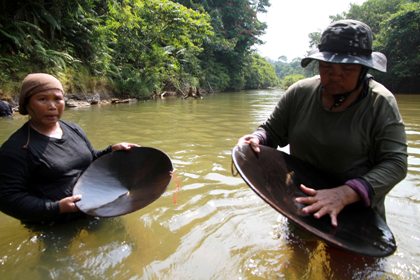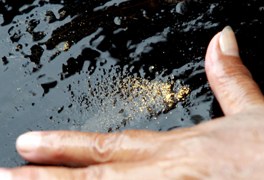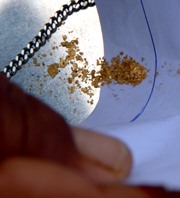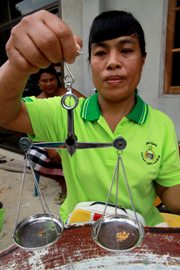Gold panning at Ban Phu Khao Thong
"In E-sarn, the people there sell their rice to buy gold. But at Ban Phu Khao Thong, we sell gold in order to buy rice," so said Auntie Saeng-aroon Chanhom, aka Pa Waen, when she described about the way of life of the residents in her village in Sukhirin district of Narathiwat.

Unlike most villages in the three southernmost provinces where the majority of the inhabitants are ethnic Malay Muslims, most of the people in Ban Phu Khao Thong are descendants of poor workers from the Northeast who settled in the village three generations ago. At the time, the government then allocated plots of land in Sukhirin district bordering Malaysia for E-sarn people to make a living.
Geologically, Ban Phu Khao Thong (literally means gold mountain) is endowed with rich natural resources, gold in particular. So gold panning has become a supplementary job for most of the villagers for decades since gold was first found there.
Gold panning is usually done during the dry season when the only creek in the village is shallow enough. After having finished with rubber tapping which takes place during the early hours of the day, Pa Waen and about ten neighbours will spend their days panning for gold dust in the creek, a tributary of Sai Buri river which flows down from Toh Moh mountain where gold deposits have been exploited.
Each gold panner carries his/her equipments for use which include a wooden pan, a spade and a can to contain gold dust. The panning process starts with scooping the sediment from the bottom of the creek and putting it in the pan, then gently agitating the water until all the gravel and dust are washed out leaving gold dust which is heavier sinking to the bottom of the pan. Then the gold dust is put in a can or any container.
"Gold panning is not easy because gold dust is not often found. When no trace of gold is found at one spot, we move to another spot and we move a lot until gold is found," said Auntie Waen, adding that sometimes they moved down the stream close to another village inhabitated mostly by Malay Muslims.
But Auntie Waen and her neighbours are mostly fortunate as they found gold everyday although in very small quantity. By average, they earn about 200 baht a day from selling gold dust. But the lucky ones may earn up to 2,000 baht a day.
She said that previously some rich villagers grouped together and employed a water pump to suck sediments from the bottom of the creek and used modern equipments to search for gold.
This led to a conflict with the poor prospectors who manually panned for gold. Finally, the provincial officials stepped in and put to a stop the use of water pumps, thus allowing the poor villagers to carry on with their gold panning.



The gold dust collected by Pa Waen and her neighbours are usually sold to Mr Krit Senaphan, a member of the tambon administration organization of Ban Phu Khao Thong because the price he offered is fair.
Mr Krit said that the gold dust he bought from the villagers is 93-94 percent pure gold. Each month, he could collect up to 200 grammes of gold dust which he sold in the provincial township.
He disclosed that the biggest gold nugget ever panned weighed about 42 grammes and was sold for 60,000 baht.
Most of the residents of Ban Phuk Khao Thong have close bondage with gold. When a new house is built, gold dust will be buried with the main pillar as an auspicious sign so that the family in the house will enjoy a happy and prosperous life.
Despite all the violence which has beset most parts of the deep South in the past nine years, Ban Phu Khao Thong remains exceptionally peaceful.
-----------------------------------------------------------------------------------------------------------------
Photo by Jaroon Thonghual
